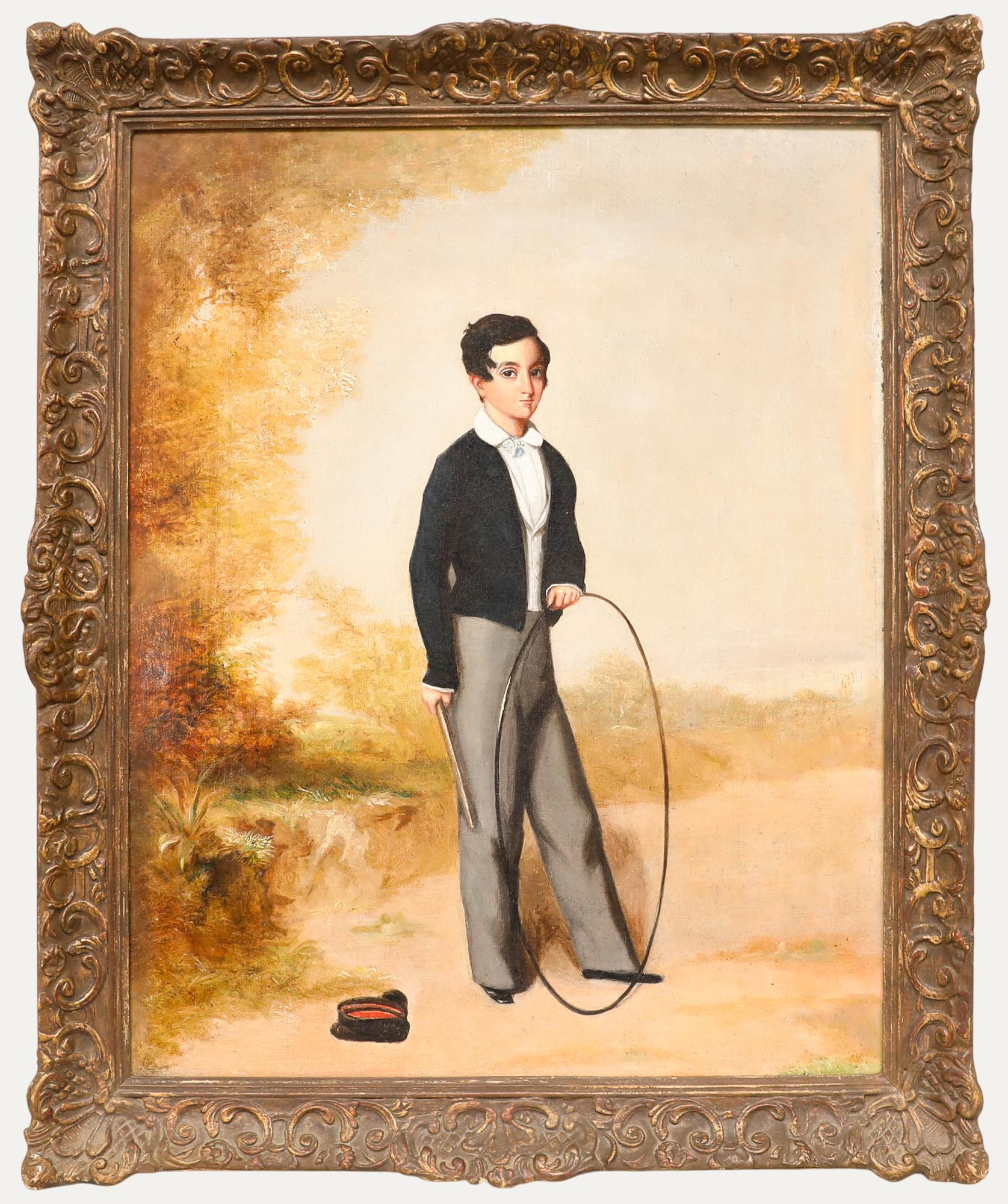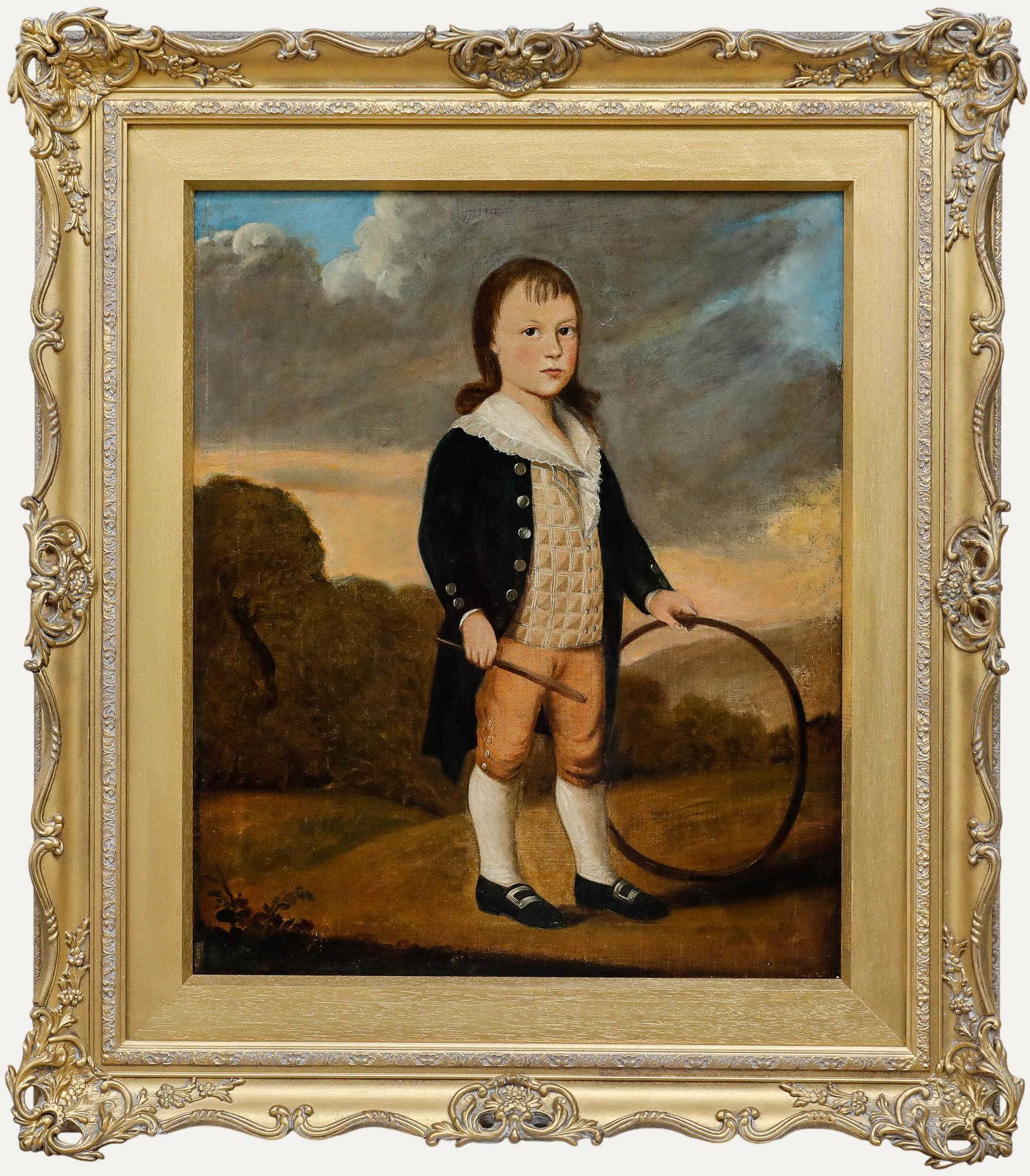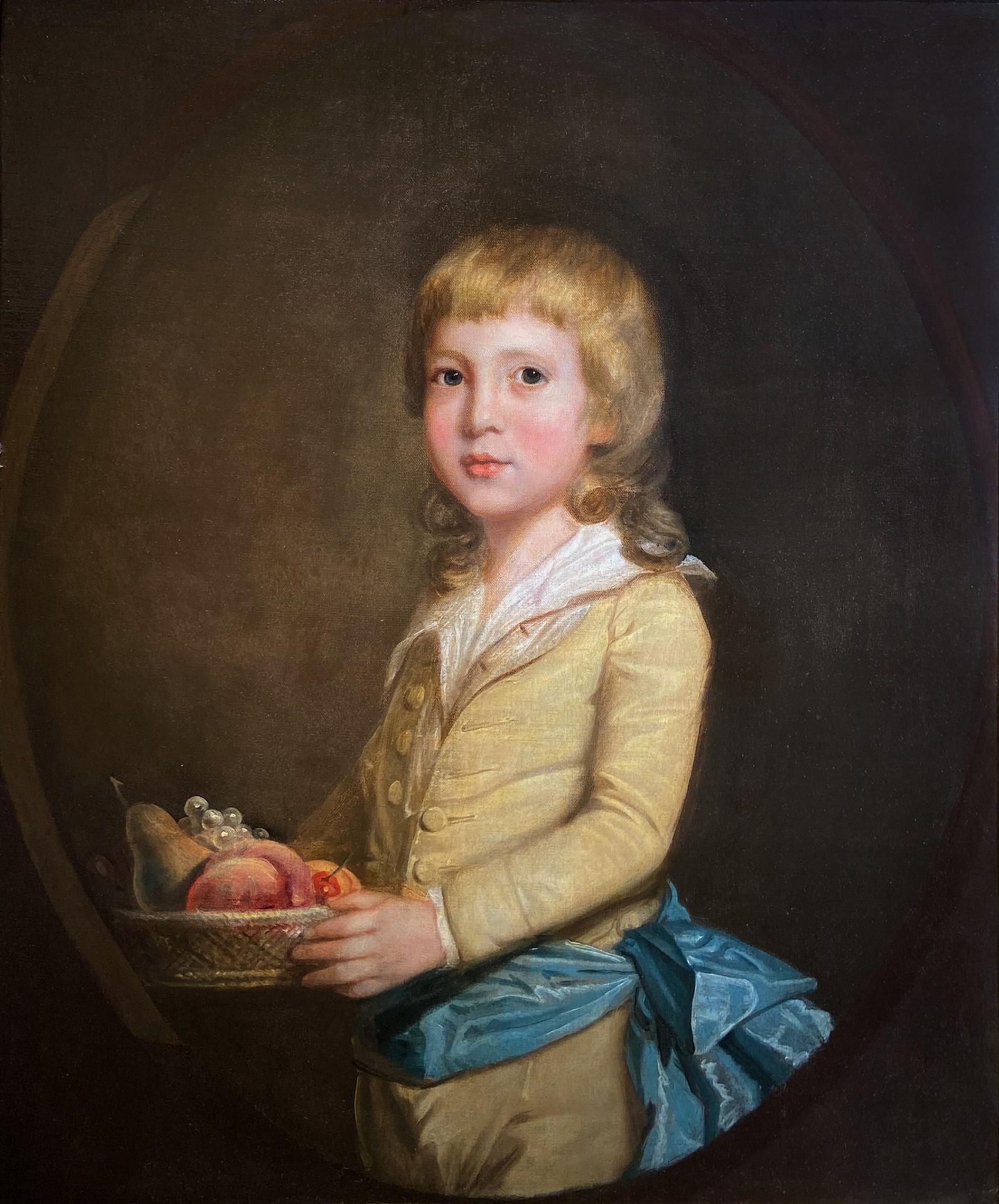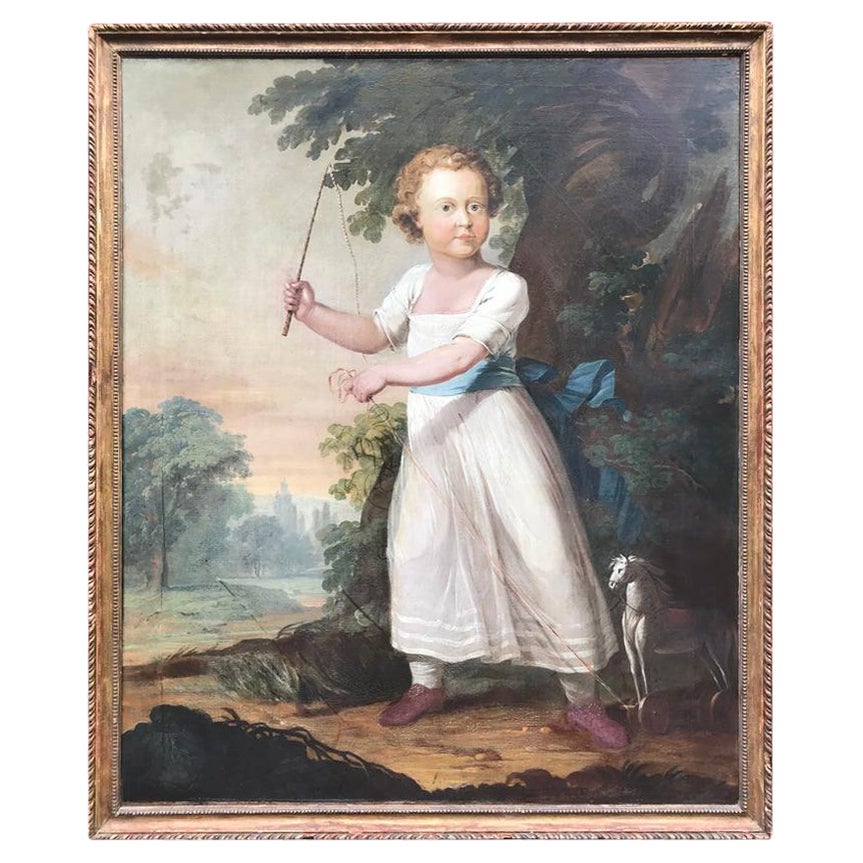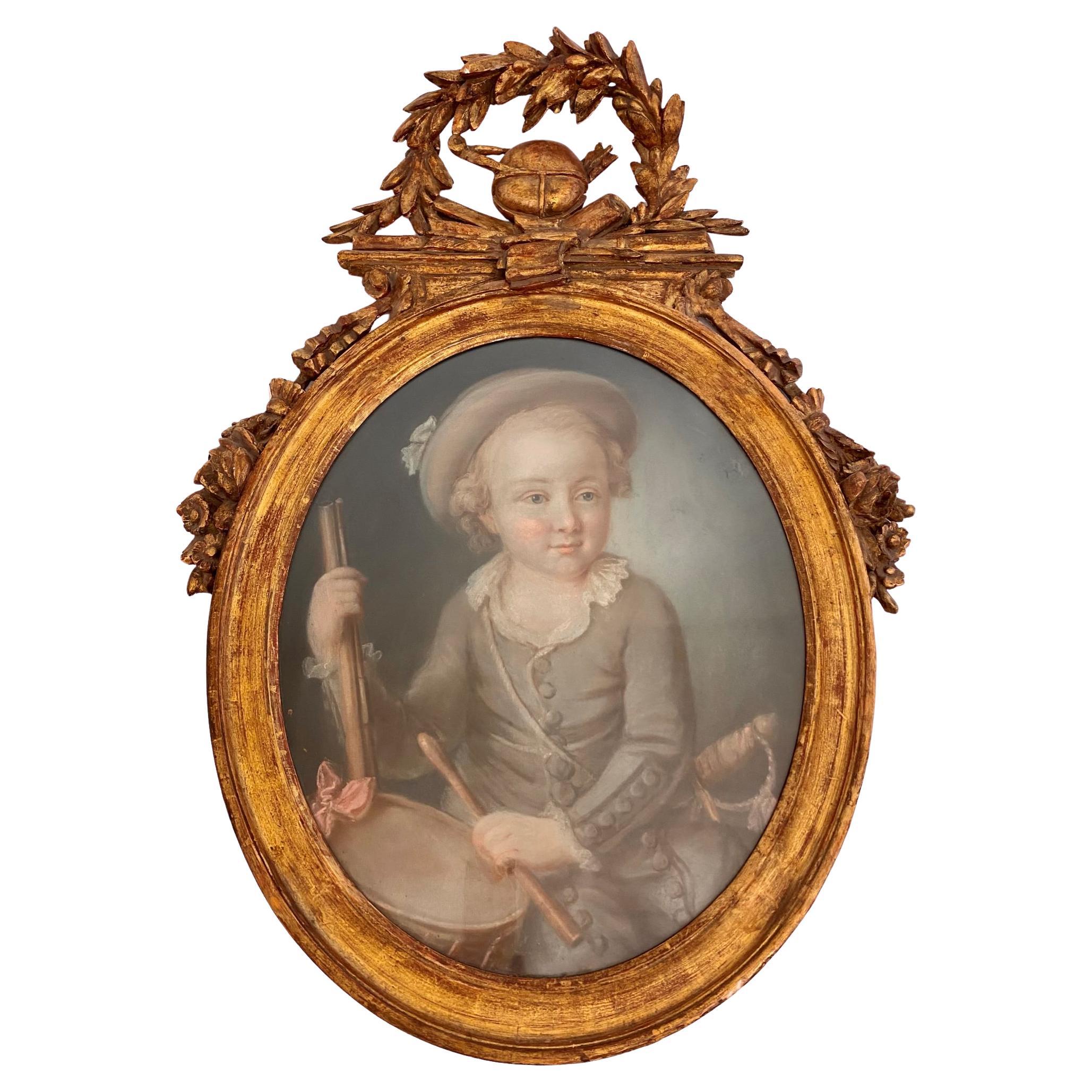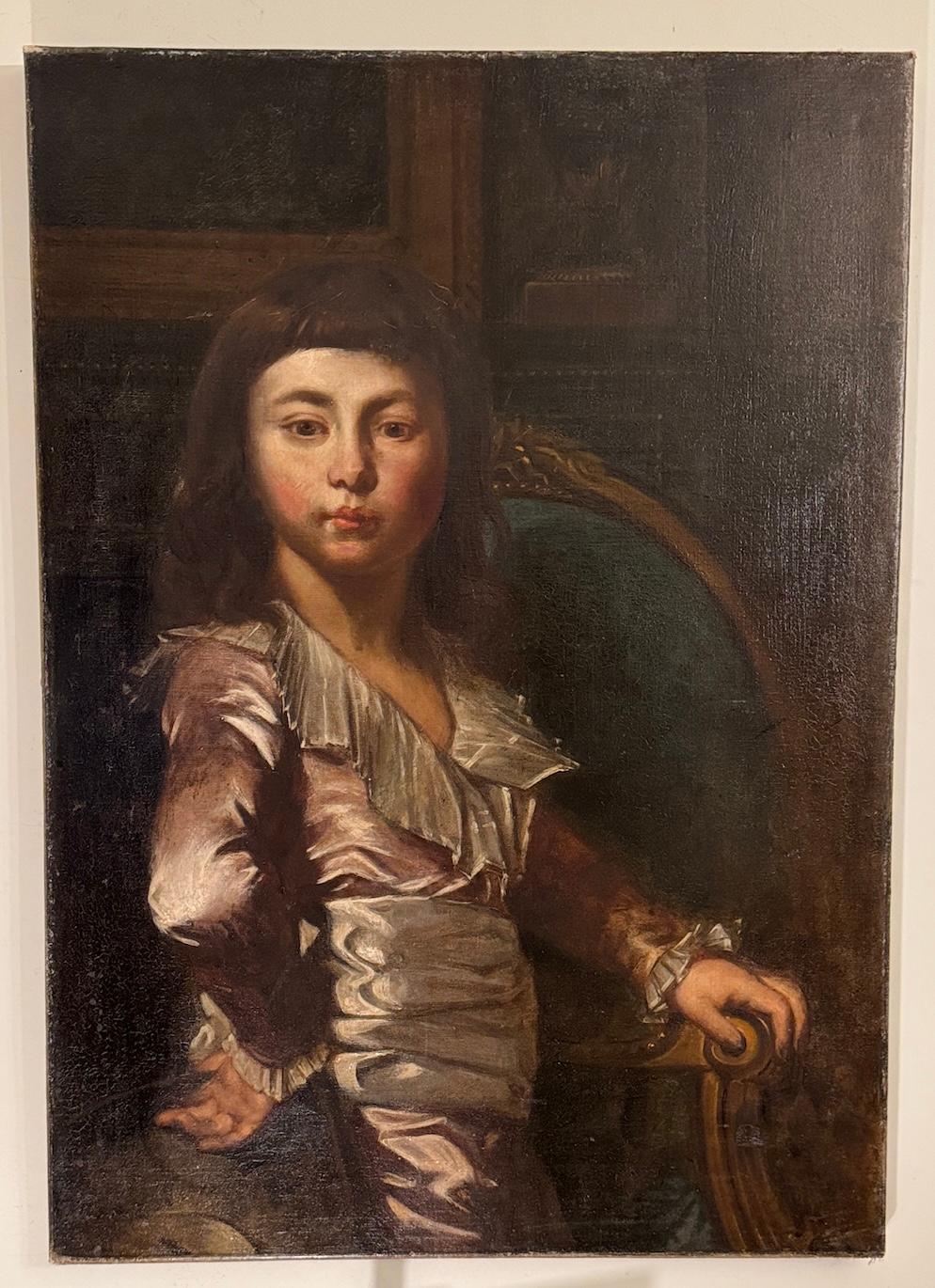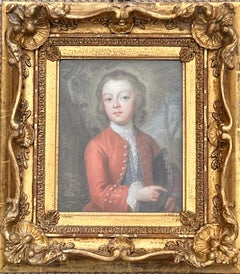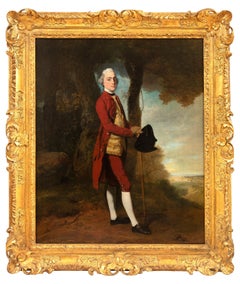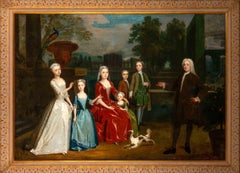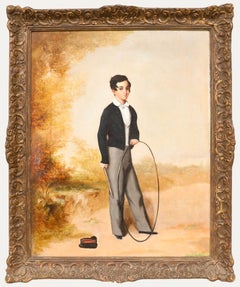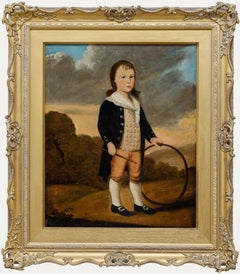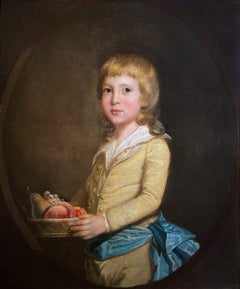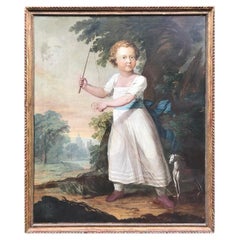Items Similar to 18th century portrait painting of a boy with a spinning top on a garden terrace
Want more images or videos?
Request additional images or videos from the seller
1 of 11
Philippe Mercier18th century portrait painting of a boy with a spinning top on a garden terrace1740
1740
$44,139.78
£32,000
€37,699.52
CA$60,630.27
A$67,417.38
CHF 35,294.21
MX$823,515.90
NOK 443,506.59
SEK 417,206.83
DKK 281,424.34
About the Item
Portrait of a young boy, full-length in a blue velvet coat and breeches, standing on a stone terrace in a garden landscape, playing with a spinning top. Signed and dated ' Phil. Mercier fecit/Ano 1740 (on the stone pedestal lower right).
Oil on canvas in a period giltwood frame
Provenance:
By descent in the King-Wilkinson family of Staidburn, Clitheroe to the following,
Mrs M.A.L. Williams, sold by her executors on behalf of the MS Society; Sotheby’s, London, 'British Paintings 1500-1850', 21 November 1984, lot 30 (featured on the catalogue front cover and sold for £38,000)
Anonymous sale; Christie’s, London, 'British Pictures 1500-1850' 22 November 2006, lot 20 (sold for £48,000)
Private collection, London
Philippe Mercier (Berlin 1689- 1760 London) was born in Berlin, the son of a French Huguenot tapestry weaver at the Royal factory. He studied in Berlin at the Akademie der Künste and under Antoine Pesne, who from 1711 was court painter to Frederick I of Prussia, whose brother-in-law, George, elector of Hanover, became king of England (as George I) in 1714. It was probably in 1716 that, 'recommended from the Court at Hanover' (Vertue, Note books, 3.37), Mercier went to London, bringing a portrait of Frederick, the little grandson of George I.
In the early 1720's Mercier's work was dominated by the influence of Watteau, with whose work he was clearly intimately acquainted and he was an important figure in the introduction of French taste in English painting. He etched a number of Watteau's works and painted variations on the theme of the fête-champêtre with either commedia dell'arte figures or English family groups of loyal Hanoverian courtiers. Such groups, of which there are fine examples at Belton House, Lincolnshire, and in the Tate collection, launched the conversation piece in British painting. Mercier was also active at this time as a picture dealer, selling a number of paintings ‘collected abroad’ (Cock's, 21 April 1724).
On becoming Prince of Wales, Frederick commissioned Mercier to paint a series of whole-length portraits of the prince and his three sisters, the princesses Anne, Amelia, and Caroline (Shire Hall, Hertford), all four being engraved by John Simon, who described them as painted in 1728. They presumably brought about Mercier's appointments in 1729 as the prince's principal painter (on 17 February) and page of the bedchamber (on 6 March). On 26 January 1730 he was also made library keeper. In addition he shared with the prince an interest in the theatre; in 1729 they collaborated in a production of Thomas Doggett's Hob at Richmond, and in 1733 Mercier was a shareholder in Rich's Theatre at Covent Garden, London. His informal portrait of Handel (c.1730, priv. coll.) further suggests his interest in the performing arts. He painted more portraits of the prince in 1730 (priv. coll.) and about 1736 (National Portrait Gallery, London), and in 1733 he painted an informal musical group of the prince with his three sisters (versions in the Royal Collection; National Portrait Gallery, London; and Cliveden, Buckinghamshire). Mercier's association with the Royal Family continued when he was appointed as drawing master to the young princesses.
In 1737 he retired from Court life and moved to York in 1739, where he stayed for thirteen years, becoming immensely popular with the local gentry. Mercier visited Ireland in 1747 and Edinburgh in 1750, but in 1751 he let his house in York and returned to London. In 1752 he went to Portugal, where he was joined by his family. It is not known how long he stayed, but one of his last portraits, of the Burton family of London (Musée du Louvre, Paris), may be dated to about 1755.
- Creator:Philippe Mercier (1689 - 1760)
- Creation Year:1740
- Dimensions:Height: 50.01 in (127 cm)Width: 40.01 in (101.6 cm)
- Medium:
- Movement & Style:
- Period:1740-1749
- Condition:
- Gallery Location:Bath, GB
- Reference Number:1stDibs: LU95215992272
About the Seller
5.0
Vetted Professional Seller
Every seller passes strict standards for authenticity and reliability
Established in 2002
1stDibs seller since 2015
37 sales on 1stDibs
Associations
The British Antique Dealers' AssociationLAPADA - The Association of Arts & Antiques DealersInternational Confederation of Art and Antique Dealers' Associations
- ShippingRetrieving quote...Shipping from: Bath, United Kingdom
- Return Policy
Authenticity Guarantee
In the unlikely event there’s an issue with an item’s authenticity, contact us within 1 year for a full refund. DetailsMoney-Back Guarantee
If your item is not as described, is damaged in transit, or does not arrive, contact us within 7 days for a full refund. Details24-Hour Cancellation
You have a 24-hour grace period in which to reconsider your purchase, with no questions asked.Vetted Professional Sellers
Our world-class sellers must adhere to strict standards for service and quality, maintaining the integrity of our listings.Price-Match Guarantee
If you find that a seller listed the same item for a lower price elsewhere, we’ll match it.Trusted Global Delivery
Our best-in-class carrier network provides specialized shipping options worldwide, including custom delivery.More From This Seller
View All18th century pastel portrait of a young boy in a wooded landscape
By Arthur Pond
Located in Bath, Somerset
This little jewel of a pastel of a young boy in his smart red jacket and silver trimmed waistcoat is by an artist working in the circle of Arthur Pond and ...
Category
18th Century English School Portrait Paintings
Materials
Pastel
$7,724 Sale Price
20% Off
English 17th century portrait of James Thynne as a young boy by a fountain
By Johann Kerseboom
Located in Bath, Somerset
Portrait of the Hon. James Thynne (c. 1680-1704), full-length, in the gardens of Longleat House, seated beside a fountain, holding a shell beneath water spouting from a horn blown by a cherub on a dolphin. A glimpse of part of Longleat House can be seen upper left. Oil on canvas in a period giltwood frame, decorated with leaves and acorns. C. 1682.
Dimensions: 145 x 123cm (57 x 48in) in frame
Provenance:
Ex Longleat House, Wiltshire
Private collection, Bath
James Thynne was the youngest son of Thomas Thynne, 1st Viscount Weymouth and Frances Finch of Longleat House, Wiltshire. He died in his youth and his Aunt, Anne Kingsmill Finch, Countess of Winchilsea (1661-1720), wrote a moving poem on his death. He was buried in the family vault at Longbridge Deverill, Wiltshire. A mezzotint of this painting by William Faithorne the Younger is held in the Royal Collection.
Johann Kerseboom (d.1708) was the nephew of Frederick Kerseboom and first worked in Germany before coming to England in the 1680's where his sitters included the 'Electress Sophia Dorothea' (known from a mezzotint by William Faithorne). His early works were influenced by William Wissing...
Category
17th Century Old Masters Portrait Paintings
Materials
Oil, Canvas
$26,483 Sale Price
20% Off
An English 18th century portrait of James Stanley, standing in a landscape
By John Hamilton Mortimer
Located in Bath, Somerset
Portrait of James Stanley (1750 - 1810), circa 1775-1778, full-length, wearing a red coat and breeches and a gold embroidered waistcoat, hold...
Category
1770s English School Portrait Paintings
Materials
Canvas, Oil, ABS
18th century painting of the Dalbiac family in the gardens of a country house
By Charles Philips
Located in Bath, Somerset
The painting depicts James (Jacques) Dalbiac, his wife Louise (ne de la Porte) and their five children, James, Charles, Louise, Marianne and Martha in the ornamental gardens of a grand country estate.
The extensive gardens extend into the distance with gardeners working in the background and figures strolling through the avenues of trees. A peacock and peahen can be seen on the wall to the left and a potted orange tree to the right. Louise Dalbiac holds an orange taken from the orange tree, aluding to the family's faith and their loyalty to the protestant King William of Orange and their adopted country.
The Dalbiacs were wealthy London silk and velvet merchants of French Huguenot origin who had fled France at the end of the 17th century to escape persecution for their protestant faith. England offered safe refuge and their skills and industriousness allowed them to establish one of the most successful businesses in London's Spitalfields which became a new centre of the silk trade, effectively leading to the collapse of the once dominant French silk industry. Both sons, James and Charles followed their father and Uncle into the family business, successfully growing the family's fortune and each going on to own their own country estates.
A conversation piece is a genre of painting used to describe group portraits of families and friends, often depicted with their servants and family pets and set within an elegantly furnished interior or the garden of a grand country house. They were a celebration of the intimacy of family relations as well as a sign of status, property and the power of succession. The informality of conversation pieces grew popular in 18th century England, allowing the sitters to present themselves in a more relaxed pose, perhaps engaged in intellectual conversation or showing their talents or interests. In this present portrait, the Dalbiacs are shown richly dressed and and at leisure in a grand country house setting, conveying their success and cultural and social aspirations.
Charles Philips (c.1703–1747) was an English artist known for painting a number of portraits and conversation pieces for noble and Royal patrons in the mid-eighteenth century. He was the son of portrait painter Richard Philips...
Category
Early 18th Century Old Masters Portrait Paintings
Materials
Canvas, Oil
18th century portrait of the German Flautist and composer Johann Joachim Quantz
By Arthur Devis
Located in Bath, Somerset
Portrait of Johann Quantz (1697-1773), flautist and composer, wearing a blue velvet coat, waistcoat and breeches, standing in a garden landscape with ...
Category
18th Century English School Portrait Paintings
Materials
Canvas, Oil
$14,897 Sale Price
20% Off
18th century portrait of sisters Lady Catherine and lady Jane Brydges
By James Maubert
Located in Bath, Somerset
This large double portrait depicts the sisters Lady Catherine and Lady Jane Brydges, the daughters of John Brydges, the Marquess of Carnarvon (1703-1727). They are seated on a stone...
Category
Early 18th Century Old Masters Portrait Paintings
Materials
Canvas, Oil
You May Also Like
British Provincial School Early 19th Century Oil - Portrait of a Boy with a Hoop
Located in Corsham, GB
A young boy holds a hoop and stick, a popular Victorian toy. He stands against a hazy autumnal backdrop. Presented in an ornate frame. Unsigned. Acquired as a pair, the companion pie...
Category
Early 19th Century Portrait Paintings
Materials
Oil
English School 18th Century Oil - Boy with A Hoop
Located in Corsham, GB
This 18th century portrait depicts a young child in formal attire standing in a pastoral landscape, holding a hoop toy. The composition juxtaposes the subject's rigid pose and ornate...
Category
Early 18th Century Portrait Paintings
Materials
Oil
Portrait of a Young Boy Carrying a Fruit Basket, 18th Century Oil on Canvas
By Thomas Beach
Located in London, GB
Oil on canvas
Image size: 30 x 25 inches (76 x 63.5 cm)
Contemporary hand-carved frame
This is a charming 18th century portrait of a young boy, sporting a golden child's two-piece w...
Category
18th Century English School Portrait Paintings
Materials
Canvas, Oil
19th Century Portrait of a Young Boy
Located in Southall, GB
Portrait of young boy playing with a wooden Horse. set in a beautiful country scene, with foliage and trees. Presented in the original hand carved gilded frame.
Category
Antique 19th Century English Paintings
Materials
Canvas
$9,379 Sale Price
20% Off
18th Century Pastel, Portrait of a Young Boy
Located in Vista, CA
18th century pastel, Portrait of a Young boy with 18th century gilt wood frame.
Category
Antique 18th Century French French Provincial Paintings
Materials
Giltwood
19th century English Portrait of a Young boy in a Cavalier costume
Located in Woodbury, CT
This elegant English 19th-century portrait of a young boy dressed in a Cavalier costume, painted circa 1860, is a striking example of Victorian portraiture that seamlessly combines h...
Category
1860s Old Masters Portrait Paintings
Materials
Canvas, Oil
More Ways To Browse
18th Century English Portrait
Antique Painting Boy
Portrait Portugal
Spinning Top
Boy George
Boyer Georges
The Little Prince
Princess Anne
Frederick Prince
French Huguenot
Antique Spinning Top
Frederick Of Prussia
George C Wales
Long Black Velvet Coat
Antique Tapestry Pictures
House Of Mercier
Antique Picture Frames Ireland
Princess Caroline
